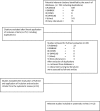Comparing the usefulness of the 1997 and 2009 WHO dengue case classification: a systematic literature review
- PMID: 24957540
- PMCID: PMC4155569
- DOI: 10.4269/ajtmh.13-0676
Comparing the usefulness of the 1997 and 2009 WHO dengue case classification: a systematic literature review
Abstract
The 1997 and 2009 WHO dengue case classifications were compared in a systematic review with 12 eligible studies (4 prospective). Ten expert opinion articles were used for discussion. For the 2009 WHO classification studies show: when determining severe dengue sensitivity ranges between 59-98% (88%/98%: prospective studies), specificity between 41-99% (99%: prospective study) - comparing the 1997 WHO classification: sensitivity 24.8-89.9% (24.8%/74%: prospective studies), specificity: 25%/100% (100%: prospective study). The application of the 2009 WHO classification is easy, however for (non-severe) dengue there may be a risk of monitoring increased case numbers. Warning signs validation studies are needed. For epidemiological/pathogenesis research use of the 2009 WHO classification, opinion papers show that ease of application, increased sensitivity (severe dengue) and international comparability are advantageous; 3 severe dengue criteria (severe plasma leakage, severe bleeding, severe organ manifestation) are useful research endpoints. The 2009 WHO classification has clear advantages for clinical use, use in epidemiology is promising and research use may at least not be a disadvantage.
© The American Society of Tropical Medicine and Hygiene.
Figures
References
-
- WHO Dengue: Guideline for Diagnosis, Treatment, Prevention and Control. 2009. http://whqlibdoc.who.int/publications/2009/9789241547871_eng.pdf Available at. Accessed October 20, 2013.
-
- Bandyopadhyay S, Lum LC, Kroeger A. Classifying dengue: a review of the difficulties in using the WHO case classification for dengue haemorrhagic fever. Trop Med Int Health. 2006;11:1238–1255. - PubMed
-
- WHO Dengue Haemorrhagic Fever: Diagnosis, Treatment, Prevention and Control. 1997. http://www.who.int/csr/resources/publications/dengue/Denguepublication/en/ Available at. Accessed October 20, 2013.
-
- Alexander N, Balmaseda A, Coelho IC, Dimaano E, Hien TT, Hung NT, Janisch T, Kroeger A, Lum LC, Martinez E, Siqueira JB, Thuy TT, Villalobos I, Villegas E, Wills B. Multicentre prospective study on dengue classification in four South-east Asian and three Latin American countries. Trop Med Int Health. 2011;16:936–948. - PubMed
Publication types
MeSH terms
Grants and funding
LinkOut - more resources
Full Text Sources
Other Literature Sources
Medical


